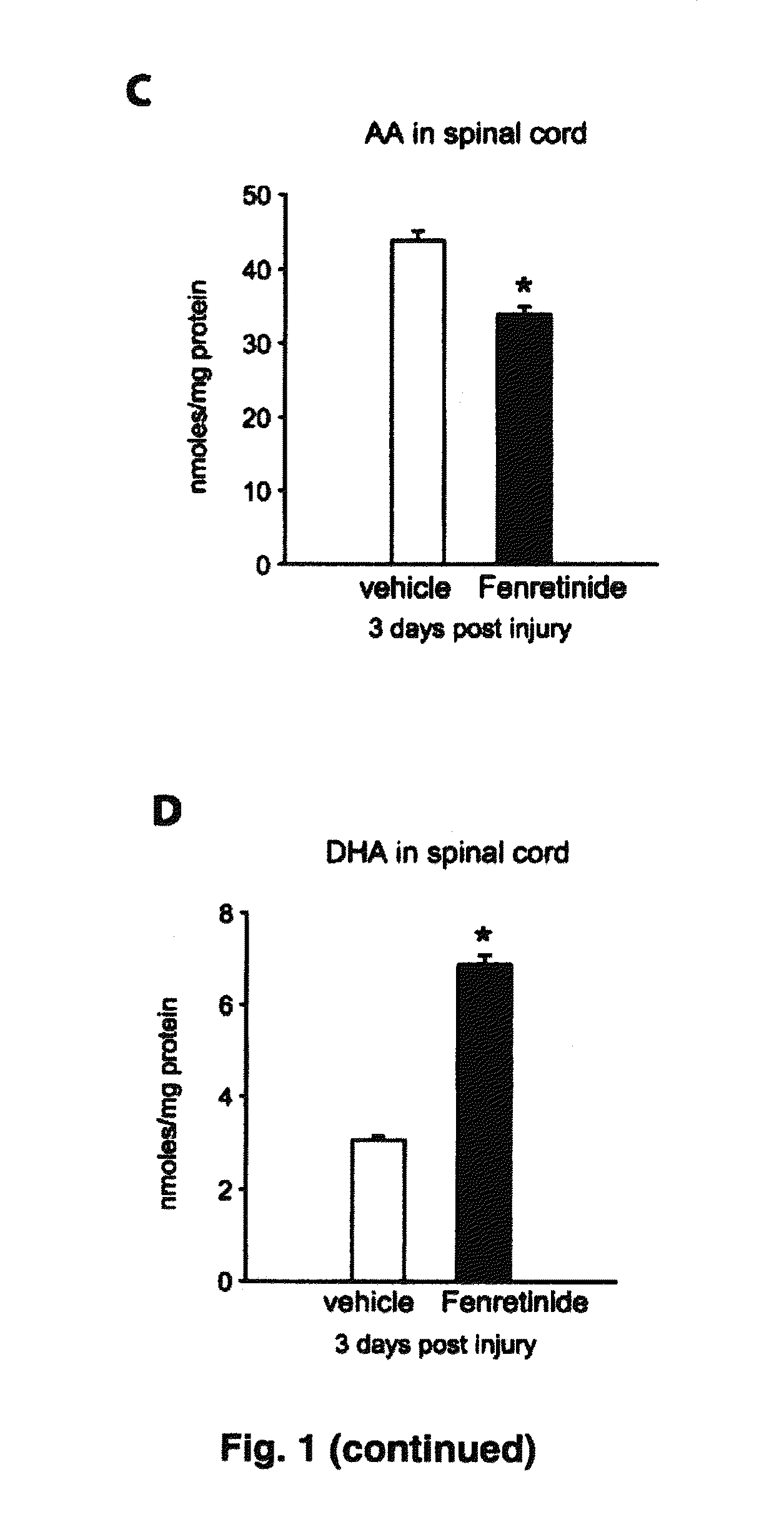Treatment of neural diseases or conditions
a neural disease and condition technology, applied in the field of neural disease or condition treatment, can solve the problems of limited efficacy and serious side effects of available pharmacological agents, destructive neurological diseases, further tissue damage and functional loss, etc., to reduce the expression of pro-inflammatory mediators, reduce the protein level of tnf, and modulate the inflammatory response
- Summary
- Abstract
- Description
- Claims
- Application Information
AI Technical Summary
Benefits of technology
Problems solved by technology
Method used
Image
Examples
example 1
Materials and Methods
[0121]Spinal cord contusion and drug administration. All surgical procedures were approved by the McGill University Animal Care Committee and followed the guidelines of the Canadian Council on Animal Care. Adult (8-10 weeks old) female BALB / c mice (Charles River Canada) were anaesthetized with ketamine:xylazine:acepromazine (50:5:1 mg / kg). After performing a laminectomy at the 11th thoracic vertebrae, the exposed spinal cord was contused using the Infinite™ Horizons Impactor device (Precision Scientific Instrumentation, Lexington, Ky.). Moderate injuries were made using a force of 50 kDynes and tissue displacements ranging between 400-600 μm (Ghasemlou et al. (2005) Exp. Neurol. 196: 9-17).
[0122]Fenretinide preparation and treatment. Fenretinide powder was resuspended in 95% ethanol under sterile conditions to generate a 2 μg / μL stock solution. This solution was incorporated into a daily liquid diet of Peptamen™ (Nestle Canada, Brampton, ON) at a dose of 5 mg / kg...
example 2
Fenretinide Modulates AA and DHA Levels after SCI
[0137]The plasma levels of arachidonic acid (AA), a pro-inflammatory fatty acid, rapidly increased as early as 1 day after SCI from 35 nmoles / mg protein to 45 nmoles / mg protein (p<0.05). The levels remained plateaued at the elevated level until day 28 (p<0.001; FIG. 1A). In contrast, the plasma levels of docosahexaenoic acid (DHA), an anti-inflammatory and protective fatty acid, is transiently increased at day 1 after SCI and then sharply decreased at day 4 post-injury and then maintained at this low level for the 28 day duration of the study (p<0.01, see figure FIG. 1B). Treatment with fenretinide resulted in a statistically significant difference in the plasma levels of AA starting at day 1 post-injury and continuing to decrease even further throughout the duration of the study. Surprisingly, this was accompanied by a concomitant increase in DHA levels in the plasma to above naïve control levels for the either duration of the study....
example 3
Fenretinide Enhances Functional Recovery After SCI
[0139]The effect of fenretinide on enhancement of functional recovery and tissue protection after SCI was evaluated. The results presented in FIG. 2A show that daily administration of fenretinide started 1 hour after SCI improved locomotor function assessed using the 9-point Basso Mouse Scale (BMS) as compared with the vehicle-treated mice (FIG. 2A; *p<0.05; Two Way RM-ANOVA, Tukey post-hoc test). Post-hoc analysis revealed significant differences in BMS score starting at day 7 dpi and remaining significantly enhanced during the duration of the follow up. At 28 dpi, vehicle-treated mice were able to step occasionally or frequently but without co-ordination (score 4.6). In contrast, mice treated with fenretinide displayed plantar stepping with occasional coordination and more parallel paw position (score 5.8). In addition, fine locomotor skills assessed by the BMS subscores also showed a significant improvement in mice treated with fe...
PUM
| Property | Measurement | Unit |
|---|---|---|
| thick | aaaaa | aaaaa |
| thick | aaaaa | aaaaa |
| length | aaaaa | aaaaa |
Abstract
Description
Claims
Application Information
 Login to View More
Login to View More - R&D
- Intellectual Property
- Life Sciences
- Materials
- Tech Scout
- Unparalleled Data Quality
- Higher Quality Content
- 60% Fewer Hallucinations
Browse by: Latest US Patents, China's latest patents, Technical Efficacy Thesaurus, Application Domain, Technology Topic, Popular Technical Reports.
© 2025 PatSnap. All rights reserved.Legal|Privacy policy|Modern Slavery Act Transparency Statement|Sitemap|About US| Contact US: help@patsnap.com



